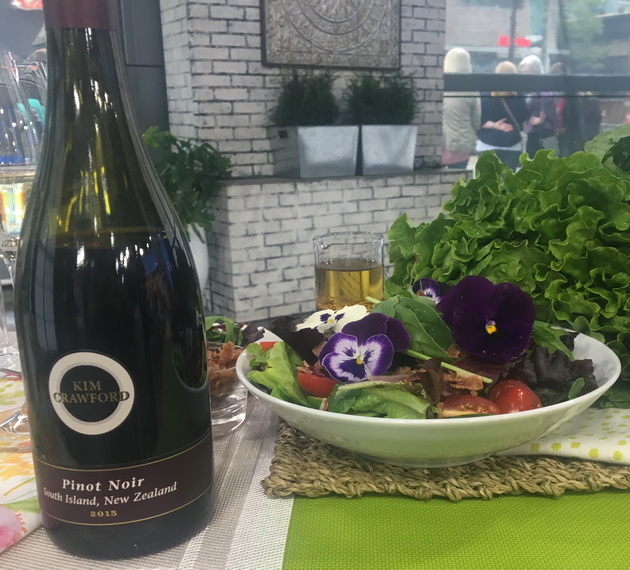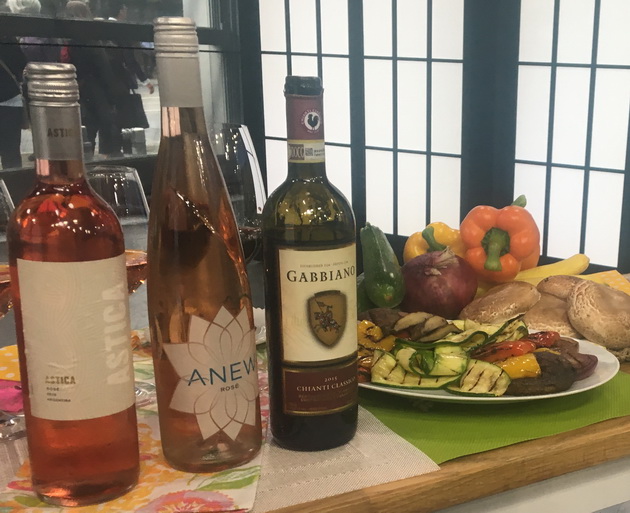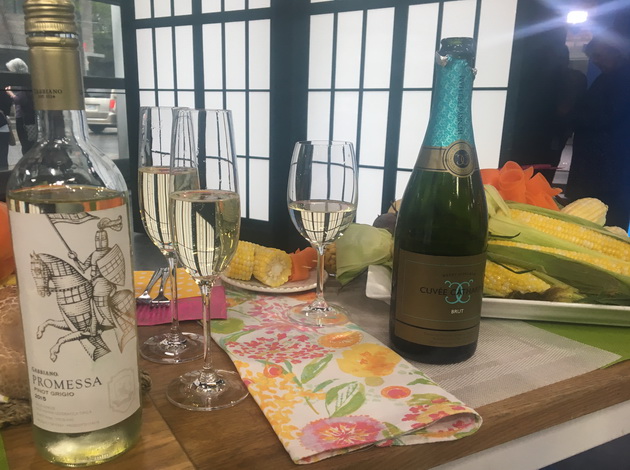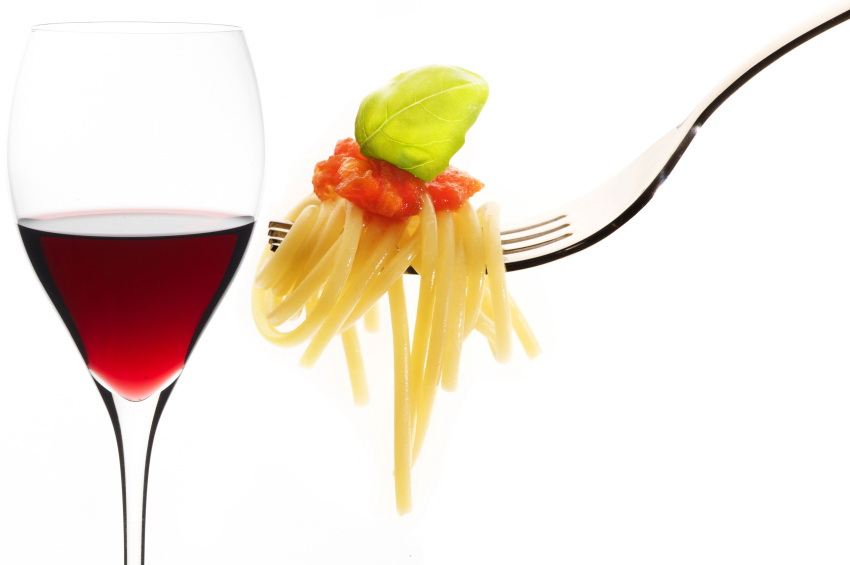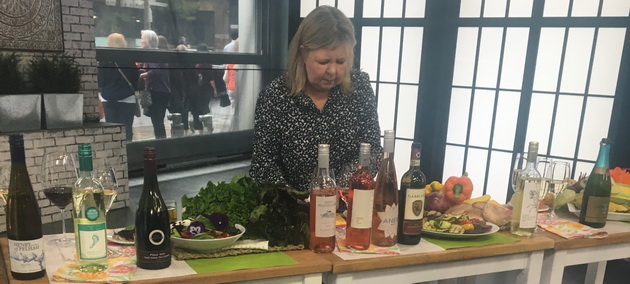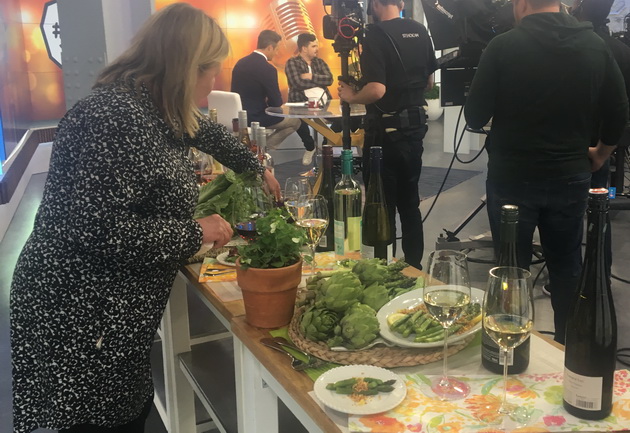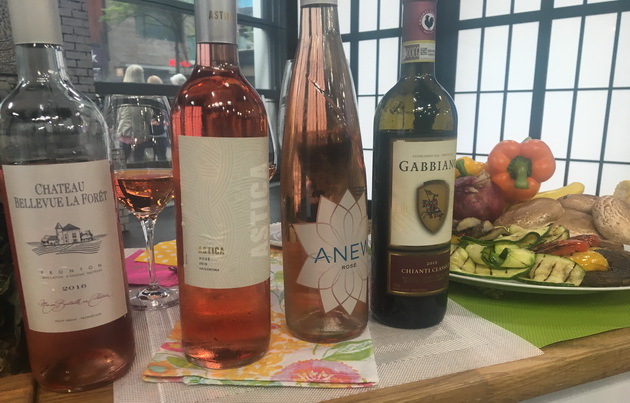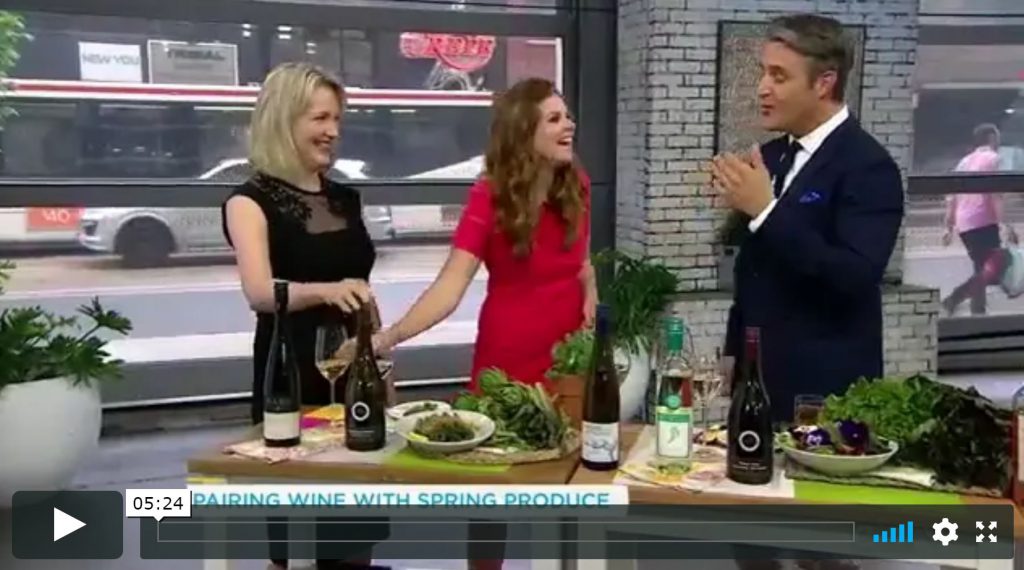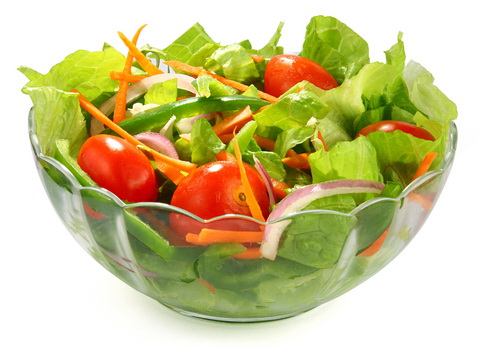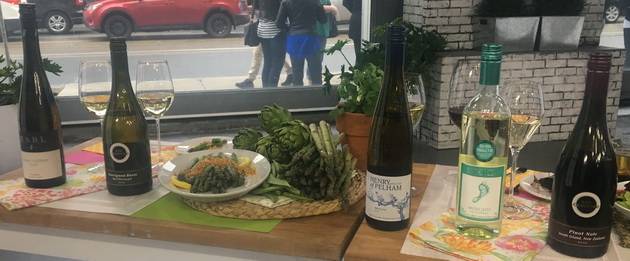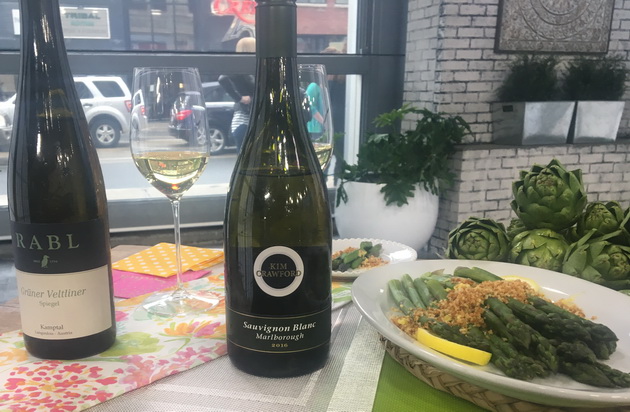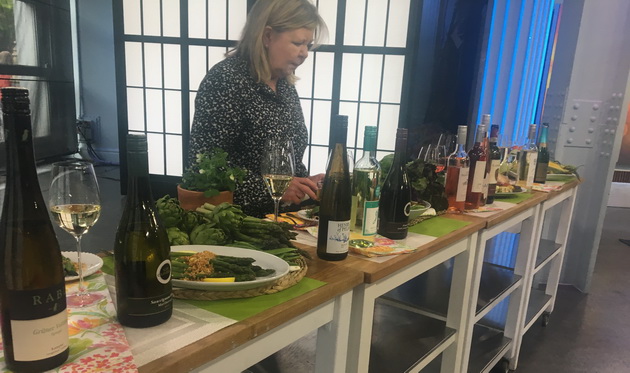On CTV’s Your Morning Yesterday, the network’s national breakfast show, we paired wine with vegetables and spring produce.
Click the video above to watch.
Intro
Pairing red wine with a steak is easy, but can you drink that same wine with fresh spring produce, like asparagus or artichokes?
Here to tell us how to pair wine with veggies and salads is Natalie MacLean, the editor of Canada’s largest wine review site at nataliemaclean.com.
Welcome Natalie
Station 1
Host: Natalie, why are vegetables harder to pair with wine than say a steak?
Natalie: With steak, you have protein which loves to dance with the tannin in red wine, that furry mouth feeling you get from eating walnuts.
However, green vegetables, like the artichoke here, haunt sommeliers because they have an organic compound called cynarin that stimulates our taste buds’ sugar receptors and fools us into thinking that everything we eat or drink afterwards is sweeter than it is, including water.
This distorts wine.
So are there any wines that work then?
Natalie: Yes, those we have here are terrific. They’re bone dry, with lots of crisp acidity so they don’t end of tasting sweet or awful when you drink them with artichokes or other spring greens.
Please try this Austrian wine to see what I mean.
Host: What about asparagus?
Natalie: Asparagus also has cynarin, though far less of it than artichokes. Its more troublesome compound is mercaptan, which can also produce a bad smell like rubber or gun flint in wine. White asparagus is even more bitter than green.
However, asparagus loves wines that have herbal, grassy aromas, such as Austrian grüner veltliner, and my favorite match is New Zealand sauvignon blanc, which is like salad in a glass.
Host tries the Sauvignon Blanc
1. Asparagus, artichoke and spring peas
Rabl Langenlois Grüner Veltliner
Kamptal D.A.C., Austria
Kim Crawford Sauvignon Blanc
Marlborough, South Island, New Zealand
Station 2
Host: Let’s move over to these salads … what are the challenges we have here with wine?
Natalie: When it comes to salads, wines with a floral character, like this Niagara Riesling do well with simple field greens, for the same reason that edible flowers are used as a garnish.
Host tries the Riesling and a sample of the field greens.
Natalie: You can also pair a wine with salads that has a touch of sweetness like this Californian Moscato, again there are floral notes.
Host: What if you have a vinaigrette on the wine?
Natalie: A vinaigrette can have intense acidity that can dull the wine’s own acidity and make it taste whimpy or flabby. Therefore, choose wines that have a healthy amount of their own acidity such as this Riesling or the crisp whites we just tasted.
Host: What if I want a red wine?
Natalie: You can have your red, especially if there’s a bridging ingredient in the salad like these bacon bits, which add some protein for the wine to match. Try to go for smooth and lighter reds like Gamay or this Pinot Noir.
Host tries the Pinot Noir
2. Spring field greens salad with a dressing and bacon bits (bridging ingredient)
Henry of Pelham Winery Riesling
Short Hills Bench, Niagara Peninsula, Ontario V.Q.A., Canada
Barefoot Cellars Moscato
California, United States
Kim Crawford Pinot Noir
Marlborough, New Zealand
Station 3
Host: Speaking of reds, I see one over here too.
Natalie: Yes indeed, red wines work with when start to grill our veggies: that charry, smoky flavour also acts as a bridging ingredient that allows for red wine to work, especially with a smoky Italian red wine like this one.
Give it a try.
Host: You also have some rose here: why does that work?
Natalie: Dry rose, like those here, brighten and lift the charry flavours of barbecue or grilled veggies and even of meats too. They have all the flavour of a red wine with those pesky tannins, so they’re a great match.
3. Grilled/BBQ veggies and Portabello mushrooms
Gabbiano Chianti
Tuscany DOCG, Italy
Château Bellevue La Forêt Rosé
Fronton, Southwest A.C., France
Anew Rosé
Columbia Valley, Washington, United States
Astica Malbec Rosé
Mendoza, Argentina
Station 4
Host: I see corn on the cob – my favourite! Which wine should I pair here Natalie?
Natalie: Starchy vegetables, like corn, go well with sparkling wine like this Niagara bubbly. The bubbles cut through the richness of the corn, especially if you have melted butter on it.
Another option is a bone-dry white wine like this Pinot Grigio, which also cuts the richness with its acidity.
4. Corn on the cob and other starchy spring/summer veggies
Henry of Pelham Winery Cuvee Catharine Brut Sparkling
Niagara Peninsula, Ontario V.Q.A., Canada
Castello Di Gabbiano Promessa Pinot Grigio
Venezie, Italy
Here’s an article I wrote with more background …
My partner Miles, an unrepentant carnivore, claims that “salad is what food eats.”
I wouldn’t go that far, but my problem with vegetables is that they are among the most challenging foods to match with wine.
Here are my favourite wines to pair with vegetables and vegetarian dishes.
Finding veggie-friendly wines, however, is important: on the one hand, many of us are now filling our plates with more greenery and less wine-friendly meat dishes; on the other, as the health benefits of wine become better known, more 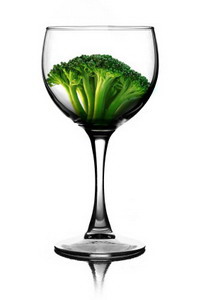 vegetarians are pouring a glass with their meatless meals.
vegetarians are pouring a glass with their meatless meals.
We’re all more health conscious, but don’t want to give up good taste. I’m fond of a tender steak, but for me, the true taste of summer is a juicy, chin-dripping tomato plucked from the garden or a crisp stalk of asparagus dripping with butter.
There are great wines for both.
Dreaded Big Reds
Let’s start with wines to avoid. The main offenders are robust reds that pair well with the hearty meat dishes that Miles loves, wines such as cabernet sauvignon and shiraz.
Not only will these full-flavoured, full-bodied wines overpower vegetables, but their tannins will clash as well. With a steak, a tannic red wine works: the meat proteins bind with the wine tannins to make them both taste richer and smoother.
But not so with vegetables; together they taste bitter, almost metallic. Mature, delicate, or complex reds also don’t work since the nuances of these wines will be overwhelmed by the veggies’ robust flavors.
If you love red wines, choose soft, smooth-textured, fruity ones, such as pinot noir, gamay, and sangiovese. Tuscan chianti, made from the sangiovese grape, is a classical regional match for most Italian dishes with tomatoes, including many pasta sauces and pizzas.
Chianti’s aromas and flavors are often described as tart and sundried, just like the tomato. In its youth, chianti can be tannic, so drink those that are at least three to five years old and decant for an hour or two.
Tomatoes Love Italian
Although raw tomatoes are tough on wine, they’re often served cooked in a multi-ingredient dish or in a sauce, such as ratatouille or marinara, which makes them less harsh.
With these dishes, you can try other juicy Italian reds, such as barbera, valpolicella, and dolcetto—all have complementary ripe red fruit aromas, a touch of spice, and a mouth-awakening acidity.
Cool-climate pinots from Burgundy, Canada, New Zealand, and Oregon have these aromas too, together with the tartness needed for tomatoes.
However, warm-climate pinots, such as those from warm regions of California and Australia, with their high-alcohol content (14 percent or more), are too ripe and flabby to hold their own with tomatoes.
Of course, not all tomatoes are created equal. The yellow, golden, and purple varieties are sweeter than the red, so they require a tart wine with ripe fruit aromas, such as those pinots from the warm regions of Californian and Australian.
You can also serve this type of wine with a caprese salad, traditionally composed of sliced tomatoes, mozzarella, basil, and olive oil, because these ingredients soften the perception of acidity in the tomatoes. Salting raw tomatoes achieves the same effect.
Better White than Red
In general, white wines do much better than reds with vegetables, but there are some exceptions. As with reds, avoid high-alcohol whites: their jammy-ripe fruit clashes with the zesty flavors of the veggies. Besides, summer greens are best enjoyed when the weather is warm, and that’s not when you want a heavy, alcoholic wine.
Starchy vegetables, such as squash, pumpkin, potatoes, and corn, go well with oaky whites: Californian, Chilean, and Australian chardonnays match the food’s creamy, buttery flavors. Anything with a smoky flavor, such as spinach cooked with bacon, marries with toasty chardonnay.
Dishes with more robust flavors, including vegetarian casserole, eggplant parmigiana, scalloped potatoes, or spinach lasagna, can handle full-flavored whites and medium-bodied reds.
Oaky whites, however, can flatten the taste of green vegetables, and these vegetables, in turn, can make the wine taste cloyingly sweet. Instead, look for versatile, bone-dry whites, with mouth-watering acidity, to pair with onions, leeks, scallions, and green peppers.
Good choices include pinot grigio, pinot blanc, muscadet, dry rosé, and sparkling wine.
Of Artichokes and Asparagus
The vegetable that most haunts sommeliers is the artichoke. It contains cynarin, an organic acid that stimulates our tastebuds’ sugar receptors and fools us into thinking that everything we eat or drink afterwards is sweeter than it is, including water.
This plays havoc with wine. Italians have made a virtue of this problem by creating a bitter-tasting aperitif called Cynar, and they’re clever at pairing artichokes with two austere, bone-dry whites that would make you pucker if you drank them on their own: verdicchio and vermentino.
Dry whites from other regions work too: chablis and aligoté from Burgundy and chenin blanc from the Loire Valley and South Africa. I call this the tough love approach to food and wine matching: you have to be mean with acidity to be kind to the flavor.
Another way to soften an artichoke’s raw edge is to cook them slowly in an acid-based liquid such as lemon juice, vinegar, or wine. This decreases their cynarin content, and turns starches to sugar. This, in turn, deepens their flavors and makes them more wine-friendly. You can also roast or caramelize them.
Asparagus is also a “wine stalker” as it too has cynarin, though far less of it than artichokes. Its more troublesome compound is mercaptan, which can also produce a bad smell like rubber or gun flint in wine. White asparagus is even more bitter than green; the rare purple asparagus is sweeter, with a mild nutty flavor.
Which wines to serve with them? My theory is that green food and green wine go together. So asparagus dances with wines that have herbal, grassy aromas, such as Austrian grüner veltliner, and Spanish macabeo, and albariño.
Although sancerre—sauvignon blanc from France—works, my favorite match is New Zealand sauvignon blanc. In fact, if there were an award for Veggie Wine of the Century, it would go to this one. Not only does it have complementary aromas of asparagus and canned peas, but it also has bright citrus notes that complement most vegetables.
Best Sauvignon Blanc Under $20
As with artichokes, you can subdue asparagus’s riotous flavors by cooking or by using sauce. Cook it in a ragout or with porcini mushrooms, and a pinot noir would suit nicely.
Dressing Your Wine
When it comes to salads, wines with a floral character do well with simple field greens, for the same reason that edible flowers are used as a garnish. Milder greens such as romaine, leaf, and Boston lettuces are gentler on wine than bitter ones such as radicchio, arugula, and endive, which can clash with the wine’s tannins.
The fat in a creamy salad dressing softens the perception of bitterness in wine and highlights its fruitiness, allowing you to drink a richer, rounder white than with a vinaigrette. However, some dressings, like homemade mayonnaise, can be too rich unless there’s some acidity.
Caesar salad, with its pungent tastes of salty anchovies, garlic, lemon, and Parmesan, cries out for a zesty white to cut through the smothering fat and stand up to the strong flavors. My favorite salad wine is a lime-fresh Australian riesling, especially from the cool Clare Valley, or a dry German riesling from the Rheingau.
If you do prefer to dress your salad with vinaigrette, beware of its intense and volatile acidity. Not only does wine’s acidity taste wimpy by comparison, but the vinegar also flattens fruit flavors.
Tame the vinaigrette’s acidity by using more oil in relation to the vinegar (five parts to one), or substitute a milder acid, such as verjus (the juice from unripe wine grapes), reduced wine, vinegars made from fruit or rice wine, sherry or balsamic vinegar (especially golden organic, which is mildest), limoncello liqueur, lemon juice, or equal parts of lemon and orange juice, for stronger wine vinegars.
In addition to tangy dressings, we often put pickled and brined foods such as capers, olives, or pickled beets in our salads. These ingredients need wines with racy, mouth-watering acidity.
Olives, for example, have a pungent, salty taste that pairs well with dry fino sherry, Spain’s popular fortified wine and a classic match for almost all tapas dishes.Wine-friendly salad ingredients such as cheese, nuts, herbs, bacon bits, and mushrooms can provide a bridge to wine, allowing you to drink earthier reds.
It’s All in Your Approach
Roasting vegetables intensifies flavors through dehydration, just as it does with meat. Grilled vegetables have a smoky, charcoal flavor, which can be brightened with a lemony wine like riesling, just as you might squeeze lemon juice on grilled fish.
Alternatively, try charred vegetables—zucchini, eggplant, and peppers—with reds that have a smoky character: Spanish tempranillo, Italian brunello di montalcino, and Canadian baco noir. The smoke-tinged sweetness of the food marries with the wine’s ripe plum and berry flavors.
Grill or sauté broccoli and green beans in olive oil to soften and round their flavors, or smother them in a butter or cream sauce, and they go nicely with a lightly oaked Californian or Chilean sauvignon blanc.
So relax about your wine choice as you sit on the patio with the sun warming the back of your neck and a light breeze wafting over the mouth-watering scent of vegetables grilling on the barbecue.
With the taste of summer on your plate and in your glass, you’ll discover that it’s not hard being green; it’s delicious.
Wine’s Salad Daze: The Ultimate Guide to Pairing Wine and Vegetables
Natalie: Thanks for coming back. The good news is the network didn’t cancel the show. The feedback is to get rid of the script. Okay, that was my grocery list but it still felt good and scary. I’m a writer. I like my life scripted but I really I’m going to try to go off-roading conversationally from now on.
So let’s taste. Now chardonnay is considered the Mae West of white wines. Everybody knows her, everybody loves her, she’s big, she’s buttery and she’s friendly. But Sauvignon Blanc, what we’re going to taste today, is leaner and meaner. I think of Dorothy Parker, my favourite writer with the acid-tongued or even Mary-Louise Parker from the TV show Weeds. We always get an unexpected but refreshing bite.
So, let’s start with the Mulderbosch Sauvignon Blanc from South Africa. You taste, I’ll talk. I first discovered this wine when I was at a Disney World South African themed restaurant. It could have been The Lion King theme music, I don’t know, but I instantly loved this wine and it went really well with the spicy African cuisine that they were serving.
So give it a sniff … liquid green and I mean that in a good way. I get fresh cut grass, chives, asparagus and canned peas. I’m not making that up and they did not add those things to the wine. Wine aromas can mimic those food aromas, give it a swirl and give it a taste. My mouth was watering before I tasted it. It’s really vibrant, isn’t it?
So this Mulderbosch is terrific. It’s $18.95 and I give it 88 points out of a hundred. A lot of South Africa Sauvignon Blancs are $13 – $15, so they are terrific bargains on the liquor store shelf.
Okay, let’s zip over to New Zealand and cut to the gratuitous map graphic again. New Zealand is the land of Sauvignon Blanc. It is the flagship white wine and one of my favourites is the Kim Crawford Sauvignon Blanc. Give it a little bit of sniff. You have liquid salad on a glass here again, very nice. And this is the reason why Sauvignon Blanc goes so well with salad and grilled veggies and Spinach Quiche. Green food, green wine … very easy to remember. This one is the Kim Crawford Sauvignon Blanc. It is $17.95 and I give it 89 points out of a hundred. It’s a little bit more than the Mulderbosch because it has this lime citrus lift in the middle of it. It’s a little bit more complex, very nice.
Last, let’s taste the Arboleda from Chile. I love Chilean Sauvignon Blanc. its personal but I do prefer them over the oaky chardonnays. This Arboleda is very refreshing and very well made. Let’s give it a swirl and again we have lovely herbal action going on the glass. What’s fabulous about this wine is that not only does it have those vibrant green aromas and the citrus lift but it also has this luscious mouthfeel which you often don’t get from Sauvignon Blancs. It’s rich and mouth filling but not heavy. I give this 89 points out of a hundred which is fabulous for $15.95. This is your best deal today of what we tasted.
So that’s it and let me know which Sauvignon Blanc you liked best of those that we tasted or any other Sauvignon Blancs that have rocked your world recently. Next week we’re going to taste some Honking Big Shiraz and Syrah. If you ever wondered what the difference is, join me next week because we have some terrific wines. They are great with a wide variety of dishes. See you next week, cheers!
Posted with permission from CTV






